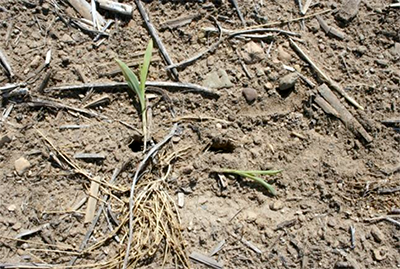Sandhill crane repellent available for one more season
Avipel, a non-lethal repellent, will significantly reduce crop damage caused by sandhill cranes.

The Michigan Section 24(c) exemption for Avipel on field, seed and sweet corn was reissued for the 2017 planting season, expiring July 2017.
Avipel is a non-lethal repellent with active ingredient anthraquinone. Sandhill cranes find anthraquinone-treated seed distasteful and learn to avoid it. Avipel liquid is a seed treatment used alone or with other pesticides, and thus must be applied ahead of time. Avipel dry is a hopper-box treatment that can be added at planting. However, it must be mixed well with the seed for even coverage.
With conservation efforts, sandhill crane populations increased in the last 50 years, to the point that crop damage is common in some areas of the Midwest. The pictures accompanying this article were taken in southern Michigan. Photo 1 shows patchy corn left after cranes damaged a field edge in northeast Cass County (note the pond in the background, making this good crane habitat). The farmer had to replant a large portion of the field, and you can see the replacement crop emerging. Photo 2 shows a close-up of crane damage in St. Joseph County; plants are typically pulled from the ground and the seeds eaten.

Photo 2. Close-up of sandhill crane damage.
Flocks of cranes can quickly destroy acres of corn once they learn to walk down the row and pluck plants as they go. Avipel can significantly reduce this type of stand loss. Although cranes avoid treated corn, they will often remain in the field to feed on pest insects such as white grubs and caterpillars—a good thing!
Additional resources and readings
- Companies stocking Avipel (there may be more): Helena, CPS, Wilbur Ellis
- Arkion Life Sciences—manufacturer of Avipel
- Protect your corn from cranes—a nice extension bulletin from the University of Wisconsin
Dr. DiFonzo’s work is funded in part by MSU’s AgBioResearch.



 Print
Print Email
Email